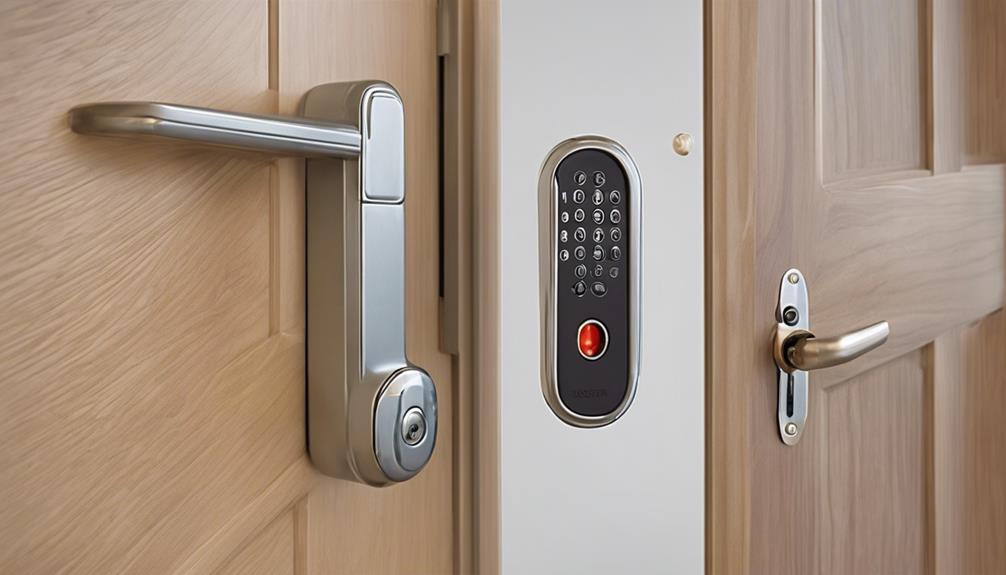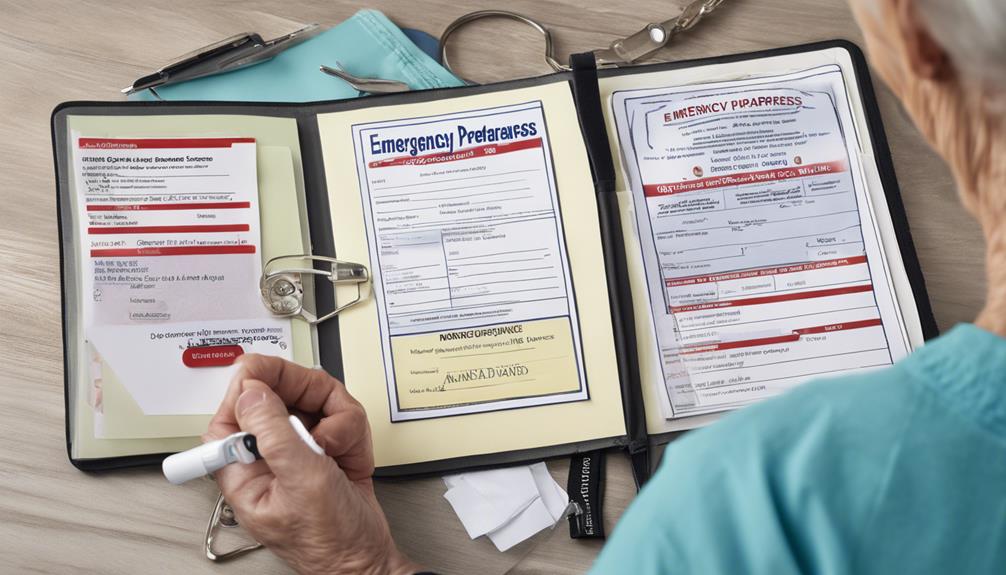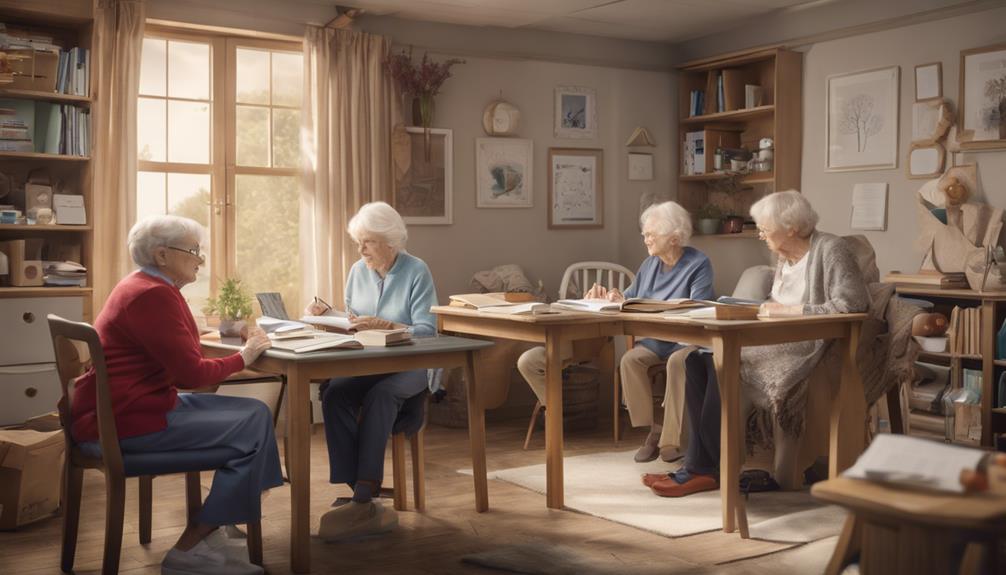To ensure prevention of dementia wandering, strategically modify the environment. Secure exits and utilize visual cues for reorientation. Monitor walking areas and outdoor spaces with locks and lights. Install alarms such as motion sensors and ID devices for safety. Educate caregivers on safety protocols and emergency preparedness. Specialized locks and alarms can improve security. Use technology for monitoring and respond promptly to elopement attempts. Ensure nationwide identification for swift emergency responses. For more information on protecting against wandering behaviors, check out additional resources and caregiver education for comprehensive support.
Key Takeaways
- Environmental modifications like camouflage doors and visual cues aid in preventing wandering.
- Secure outdoor spaces with fences, motion-activated lights, and designated walking areas.
- Implement safety protocols such as locks, alarms, and emergency preparedness programs.
- Utilize specialized door locks and alarms for restricted access and monitoring.
- Ensure caregiver education, resources, and nationwide identification for effective wandering prevention.
Risk Factors for Dementia Wandering
Cognitive impairment greatly heightens the risk of dementia wandering. Individuals with dementia may experience restlessness and agitation, acting as triggers for wandering behavior. Past incidents of wandering also increase the likelihood of future episodes.
Changes in medication or environment can contribute to this behavior, making it important for caregivers to monitor these factors closely. Recognizing potential triggers like confusion, anxiety, or boredom is essential in preventing wandering among dementia patients.
Caregivers play an important role in identifying early signs of agitation and addressing them promptly to minimize the risk of wandering. By creating a safe and engaging environment, caregivers can help reduce the chances of their loved ones wandering.
Understanding the risk factors associated with dementia wandering empowers caregivers to take proactive measures in providing proper care and supervision. Through education and awareness, caregivers can enhance their ability to prevent wandering incidents effectively.
Environmental Modifications for Prevention

When aiming to prevent wandering in individuals with dementia, making specific environmental modifications is essential.
Safe room design involves strategies like camouflaging doors and windows to discourage wandering behavior and ensuring secure outdoor spaces to limit unsupervised access.
Safe Room Design
Implementing environmental modifications in the form of safe room design is essential in preventing dementia patients from wandering. When creating a safe space for individuals with dementia, consider the following measures:
- Camouflaging doors and windows to make exits less visible.
- Using dark-colored doormats to deter inappropriate door usage.
- Incorporating visual cues like descriptive photos on room doors for reorientation.
- Posting stop signs strategically to prevent access to risky areas.
- Providing supervised areas for walking or pacing to offer a safe space for wandering individuals.
Secure Outdoor Spaces
To enhance the safety of individuals with dementia, our focus shifts to securing outdoor spaces through various environmental modifications aimed at preventing wandering behaviors.
Using fencing or gates with secure locks can help deter outdoor wandering. Landscaping dense shrubbery or hedges around outdoor areas acts as a natural barrier against wandering. Installing motion-activated lights enhances visibility and discourages nighttime wandering.
Designating specific outdoor areas for supervised walking or gardening provides safe options for physical activity. Additionally, creating secure seating areas outdoors allows dementia patients to enjoy fresh air while reducing the risk of wandering.
Safety Protocols for Caregivers
As caregivers, we prioritize the safety of individuals with dementia by implementing proactive measures to prevent wandering incidents. Ensuring a secure environment for our loved ones is vital, and there are several safety protocols we can put in place:
- Install locks and escape prevention devices: Securing doors, windows, and gates with keyless electronic locks can help restrict unsupervised exits, reducing the risk of wandering incidents.
- Utilize anti-wandering alarms: Motion sensors and pressure-sensitive mats can alert caregivers of any attempts at elopement by dementia patients, enabling quick intervention.
- Make environmental modifications: Disguising exits and creating safe wandering spaces can help manage restlessness and disorientation in individuals with dementia, minimizing the urge to wander.
- Prioritize emergency preparedness: Enrolling in programs like the Safe Return program by the Alzheimer's Association ensures nationwide identification and 24/7 emergency response in case of wandering incidents, providing peace of mind for caregivers and families.
Specialized Door Locks and Alarms

Specialized door locks and alarms are essential tools in keeping individuals with dementia safe. These devices provide security by preventing wandering and alerting caregivers to any potential risks.
Locks for Safety
When considering dementia wandering prevention, implementing specialized door locks and alarms becomes essential for ensuring the safety of individuals with dementia at home. These measures provide security and peace of mind for caregivers and prevent elopement incidents.
Keyless electronic locks offer restricted access to certain areas, ensuring the safety of dementia patients. Sliding bolt locks discreetly installed on doors help prevent wandering while allowing supervised movement within the home. Anti-wandering alarms, such as motion sensors and pressure-sensitive mats, alert caregivers to potential elopement attempts swiftly.
Additionally, door monitors with remote receivers provide added security by notifying caregivers of any unauthorized exits, enhancing overall safety measures at home.
Alarms for Monitoring
To enhance monitoring capabilities and prevent elopement incidents, alarms play a critical role in ensuring the safety of individuals with dementia at home. Specialized door locks, like keyless electronic locks, and alarms such as motion sensors and pressure-sensitive mats, can help caregivers stay alert to potential wandering behavior.
Door and window monitors with alarms provide an additional layer of security, notifying caregivers of movements or attempts to leave the house. By integrating traditional home security systems with contact sensors, caregivers can further enhance the safety measures against dementia wandering.
These anti-wandering alarms not only aid in monitoring but also enable caregivers to respond promptly to any elopement attempts, reducing the risks associated with wandering behavior and providing peace of mind to caregivers.
Technology for Security
How can advanced technology enhance the security measures for individuals with dementia at home? For dementia patients, specialized door locks and anti-wandering alarms play an essential role in ensuring their safety. Here are some key technologies to take into account:
- Specialized door locks like keyless electronic locks and discreet sliding bolt locks provide secure access control.
- Anti-wandering alarms, including motion sensors and pressure-sensitive mats, alert caregivers of potential elopement attempts.
- Door and window monitors integrated with alarms notify caregivers of movements or attempts to leave the home.
- Environmental modifications such as disguising entrances and using visual cues like stop signs help prevent wandering behavior.
Emergency Preparedness and IDs

What emergency measures can be implemented to enhance the safety and well-being of wandering seniors with dementia?
It's vital to have a thorough plan in place for emergency preparedness. Utilizing tools like medical ID jewelry can provide access to a nationwide identification system, ensuring quick response from an emergency response team in case of wandering incidents. These IDs offer critical information and aid in caregiver concerns by facilitating missing person reports.
Additionally, incorporating recent photos and physical descriptions in the plan can assist in worst-case scenario preparation for wandering seniors. Considering anti-wandering products and strategies can further enhance safety measures.
Caregiver Education and Resources

Understanding the challenges of dementia behaviors and the resources available to caregivers is essential for effectively managing wandering incidents. As caregivers, we must equip ourselves with the necessary tools and knowledge to provide the best care possible for our loved ones with dementia.
Here are some key points to take into account:
- Caregiver resources: Options such as in-home care, assisted living communities, memory care facilities, nursing homes, and elder law attorneys can offer valuable support and guidance.
- Dementia behaviors: Recognizing the fluctuating nature of dementia behaviors is vital in dealing with wandering incidents.
- Sleepless nights: Coping with sleep disruption caused by dementia-related behaviors like wandering can be physically and emotionally draining for caregivers.
- Manipulative behavior: Addressing manipulative behavior in elderly individuals with dementia requires patience, empathy, and specialized care techniques.
- Educational materials: Utilizing educational materials and supportive information can help caregivers navigate the complexities of dementia wandering and prevention measures effectively.
Memory Care Communities and Support

Memory care communities offer specialized housing and 24-hour care for seniors with dementia, focusing on tailored activities and secure environments to reduce wandering risks. These communities provide a safe and supportive setting for seniors who require specialized care due to their cognitive impairments.
By offering personalized care plans and cognitive stimulation, memory care communities aim to enhance the quality of life for seniors with dementia while ensuring their safety. Families seeking appropriate care options for their loved ones can benefit from the expertise of Senior Living Advisors who assist in finding the most suitable memory care community that meets the needs of dementia patients.
With a focus on individualized attention and secure surroundings, these communities provide a comforting and structured environment that promotes well-being and helps manage the challenges associated with dementia. Through dedicated care and a commitment to supporting seniors with dementia, memory care communities play a crucial role in improving the lives of those in need of specialized care.
Frequently Asked Questions
How Can We Prevent Wandering Dementia?
To prevent wandering in dementia patients, we focus on safety measures like door locks, alarms, and visual cues. Providing secure spaces, disguising exits, and preparing for emergencies are essential steps. Addressing caregiver concerns with resources like safety gates and supportive communities can help.
What Intervention Is Best for a Client With Dementia Who Wanders?
When a client with dementia wanders, we prioritize understanding their needs and emotions. By providing personalized care, implementing distraction techniques, and creating a safe environment, we can help manage wandering behavior effectively and compassionately.
What Are 3 Behaviour Modification Strategies You Could Use to Help Manage Wandering Behaviour?
We implement distraction techniques, structured routines, and a safe environment to manage wandering behavior in dementia patients. These strategies redirect attention, provide predictability, and enhance orientation, reducing disorientation and the urge to wander.
What Are 3 Things Not to Say to Someone With Dementia?
In our journey of caring for others, let's remember to avoid phrases that may cause distress to someone with dementia. Let's show kindness by refraining from saying things that could lead to confusion, frustration, or embarrassment.
Conclusion
To summarize, preventing dementia wandering is vital for the safety of individuals living with dementia. By incorporating environmental modifications, safety protocols, specialized door locks, and caregiver education, we can significantly decrease the risk of wandering incidents.
Keep in mind, these measures are indispensable in ensuring the well-being of those with dementia. Stay watchful, stay informed, and take action to create a safe and secure environment for your loved ones. Additionally, fostering open communication with healthcare professionals is crucial in navigating dementia and mortality, as it helps you prepare for the progression of the disease. By staying proactive and making informed decisions, you can better support your loved ones and ensure their dignity and comfort throughout the journey.









